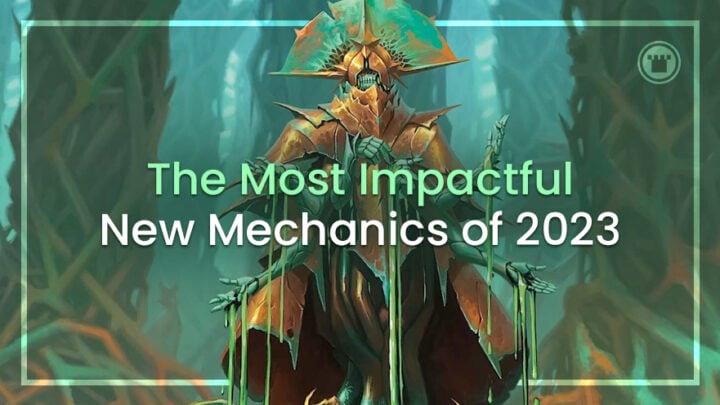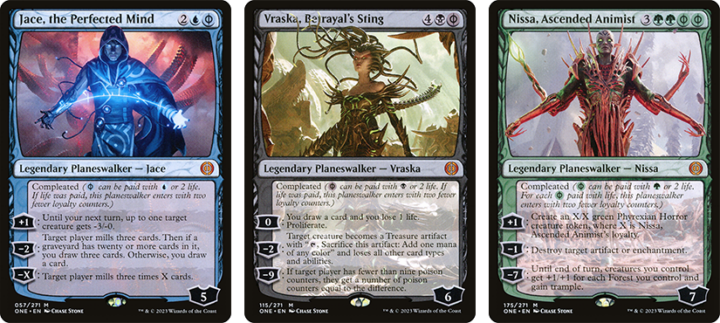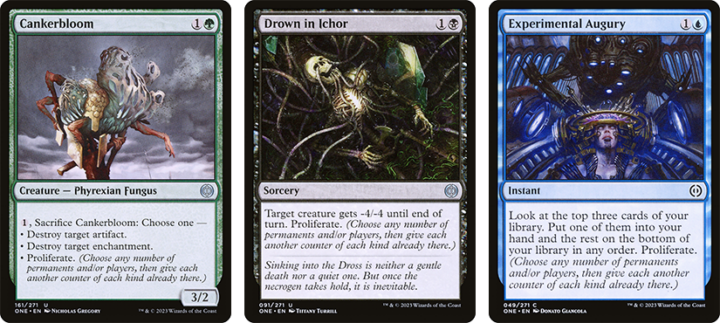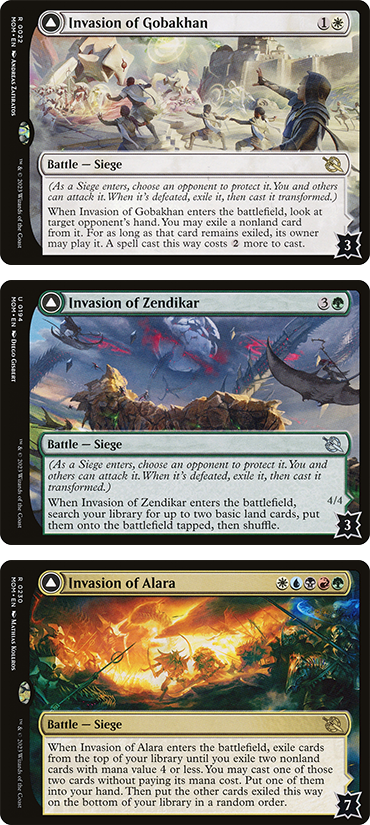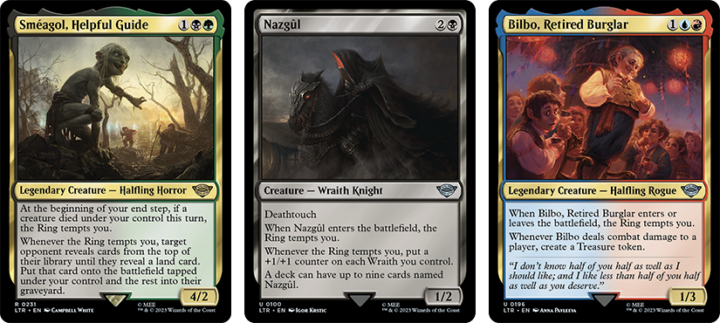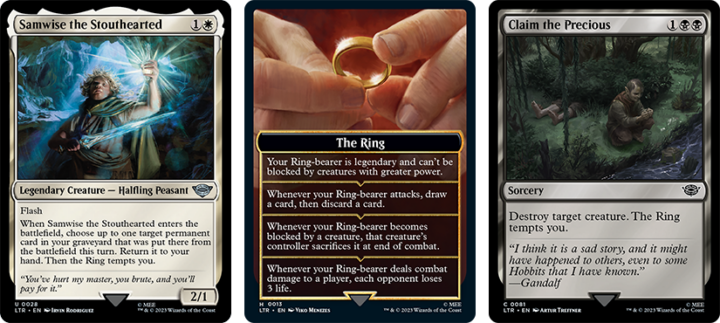During previews and release windows of new Magic expansions, we tend to focus on the impact of their strongest individual cards. But over time, as those cards become familiar parts of the broader metagame, it’s the unique mechanics which come to define that set in the collective memory.
Taking the Limited perspective, these mechanics essentially ARE the set – you certainly interact with them more often across various commons and commons than you do any individual bomb rare. And for Commander players, each mechanic represents a full suite of naturally synergistic cards, with potential to form the backbone of a good singleton list! Even if you don’t have a deck which can utilize Oil counters or Descend right now, those sets can become a confident starting point when building any similar archetype in the future!
Now that Lost Caverns of Ixalan has delivered the final chapter for Magic in 2023, let’s take this opportunity to revisit some of this year’s biggest mechanics and their long-term impact on the game.
The Triumph of Phyrexia
By far my favorite surprise of 2023 when it comes to mechanics, Phyrexia: All Will Be One successfully redeemed some of the most dubious design choices of the current millennium. I was extremely skeptical about the wisdom of revisiting infect, proliferate, and Phyrexian mana before the set came out, but I’ll happily admit to being extremely wrong.
The designers of ONE showed tremendous insight into exactly what aspects of these mechanics had been problematic in the past. Even more impressively, they were able to then create a set’s worth of new cards which negated those dangers – sometimes without even needing to actually create a new version of the mechanic!
Poison counters have always been a bad experience in part because they were completely divorced from regular combat damage – you had to go all-in on one or the other. Replacing Infect with Toxic to decouple it from the creature’s actual power is a win-win: the creatures who have the ability are now allowed to have reasonable combat stats, and other players don’t have to live in fear of Groundswell and Scale Up ending games in the first three turns.
For the other two scary mechanics, all it took was a more considered approach about where to deploy them. Instead of putting their hand on the always-hot stove marked “free spells”, WotC mostly used Phyrexian mana costs on situational activated abilities. Because there’s not always a benefit to activating Skrelv or the Dominii every turn, the option to use life becomes a truly meaningful choice, rather than an automatic one.
The compleated Planeswalkers demonstrate an even smarter approach to counterbalancing this extremely powerful option. Planeswalker cards are already designed around a relatively fixed sequence of choices regarding their activation, so the designers can much more easily predict and control the benefits of a reduced casting cost.
Proliferate in ONE was restricted to single-use triggers (except for Tainted Observer, a few mythics, and the reprinted Thrummingbird), which strikes me as a good start.
There also seems to be some consistent limitations to the cards it appears on: either you don’t have full control over when you can trigger proliferate, or the way you trigger it leaves you behind on board relative to the mana spent. Sometimes you have to tap or sacrifice a creature, sometimes you just have to use cards or mana less efficiently to get the counters. But you’re always giving something up to do so, which makes proliferate – as with Phyrexian mana – more of a tempo-dependent decision than the easy inevitability it was before.
I’ve heard it argued that there’s almost no inherently bad mechanics, just poorly utilized ones. The re-imagined mechanics in ONE did more to sell me on that optimistic theory than ever before.
The Real Battle Starts Now
It would be remiss of me to write a “most impactful mechanics” list without at least acknowledging the debut of Battles in March of the Machine. After all, it’s the first new card type since Planeswalkers! However, other than triggering an official update to the size of the Maximum Theoretical Tarmogoyf, it seems like the long-term implications of Battles are still unclear going into 2024.
Whether it’s the inherent risk involved in the “paying to set up a bonus objective” play pattern the current Battles create or just that they don’t have the right kinds of effects attached to them, only a modest number of Battles have made it to Constructed play. I don’t see that changing in a hurry either, unless WotC continues to sprinkle in highly efficient “remove counters from target permanent” effects.
As much as I appreciate the idea of secondary objectives in Magic, the ever-increasing tempo of games is going to make Battles (or at least the Siege variety we have now) tough to balance. I just hope that WotC is brave enough to take another shot at them sometime soon, maybe in a Commander precon, because a greater density of dedicated and synergistic support for Battles would go a long way.
The Folly of Sauron
On the whole, I think Tales of Middle-earth nailed almost any design goals WotC could have had for it. The set sold well. It got positive attention from both the established playerbase and outsiders. The art direction captured a vision of Middle-Earth that was distinct from the iconic Peter Jackson movies and other adaptations, but still recognizable to fans.
Even the power level seems decently judged for a “Modern Horizons” set, with only one or two potentially bannable cards and a lot of fun playables. However, the “ring-bearer”/”The Ring tempts you” mechanic was so messy that it genuinely tarnished my overall impression of the set. Looking at it again now, months later, I’m afraid I’m no closer to understanding this design.
Deciding to use another “trigger-counting emblem” mechanic so soon after The Initiative is questionable to start with. Aside from inherent balance concerns, the amount of ephemera required to represent this mechanic is just exhausting: an outside-the-game rules card to explain the effect, an emblem plus tracking token to represent its current properties, and an additional way to track which creature it’s currently applied to.
The need for so much fiddly extra cardboard is especially questionable since Magic already has very well-established ways to show how a piece of “equipment” or magical “aura” could be “attached” to a specific creature! But instead of re-using these familiar rules concepts, WotC decided to try re-inventing the mechanical wheel… and then came back holding a square.
It all feels like a collision of opposing priorities, trying too hard to encapsulate the complex capstone of Tolkien’s epic. The need to have the Ring influence every game of Tales of Middle-earth demanded a mechanic which could appear on any card type across every color and archetype. The desire to represent so many aspects of its myth necessitated the awkward multi-stage emblem and odd list of effects. But then they removed any reference to the Ring’s most infamous trait – that it corrupts and ruins those who wear it – because testing groups said adding drawbacks made the mechanic unplayable!
I’m normally a huge fan of top-down designs when the source material is so evocative. But the only way in which this mechanic resonates with Tolkien’s lore is that I want to drop it in a volcano.
Role’d Gold
Perhaps I wouldn’t be quite so harsh on the bizarre choices made for the ring-bearer mechanic had the very next set not made such amazing use of pre-defined aura tokens!
As a top-down design set with transformation-heavy fairy tale themes, Wilds of Eldraine could have easily been done with all double-sided cards like an Innistrad set. Besotted Knight would transform into a “Beauty + Beast” duo. Cursed Courtier would start as a lowly frog which you have to flip into a powerful noble. Twisted Sewer-Witch would create rat tokens as the front side ETB, and then trigger a buff to all Rats you control as a trigger when it transformed. This is a method of storytelling through design which WotC is already very comfortable with.

But the previous DFC-heavy Innistrad sets haven’t even left Standard yet, and Wilds had an enchantment theme to deliver on. So instead the designers came up with this elegant set of pre-defined aura tokens, allowing for a more free-wheeling interpretation of “transforming roles” that also massively expanded the available design space!
The biggest win is being able to utilize this concept of changing states on cards other than the changing creatures themselves: compare the flexible usage on Return Triumphant or Vantress Transmuter to Waxing Moon or the handful of other spells that indirectly reference transform.
Even while asking players to juggle six roles in one set, piggybacking off evergreen aura mechanics and sticking to simple, flavorful abilities with a consistent stat bonus kept the learning curve on Roles to a minimum. I really think this is a kind of design we will slowly see pop up in more and more sets – just as Clue tokens eventually led to more consistent usage of activatable utility tokens like Food, Blood, and Incubators.
But even sticking to their impact in the present, it’s impressive how well Roles managed to resolve several historic design challenges. Making heavy use of aura tokens (along with Food and the “can’t block” clause on Rats) ensured players could always fuel Bargain and Celebration without giving them unlimited chump-blockers, which often invalidates the combat step in token-heavy Limited sets. Likewise, handing out Roles as a bonus on other cards makes aura-themed decks much less of a gamble, as you’re no longer getting two-for-one’d every time someone casts removal on an enchanted creature!
A Year of Thoughtful Innovation
Looking back now, I have to say I’m impressed at how many new mechanics worked out this year. Not just new tweaks on existing keywords either, but some real leaps forward to discover new ways of writing Magic cards.
Sometimes these designs didn’t quite stick the landing, or it turned out that the whole direction was probably not worth exploring any deeper; I personally hope we’ve seen the last of these multi-stage emblems as a graceless way to lasso otherwise unrelated cards together into a synergistic archetype. But for a game entering its fourth decade of uninterrupted development, experimentation (and the accompanying chance of duds) is essential.
I didn’t end up including Lost Caverns of Ixalan in this piece, partially because I just explained a lot of my opinions in my Draft Guide and spoiler season previews. But that set is no less energetic in trying new ideas and reinterpreting old ones, all in a way that serves the flavor and lore of the set. I’m confident that Magic in 2024 will continue in this confident design paradigm, and I’m excited to try and predict what that will mean for sets like Murders at Karlov Manor and Outlaws of Thunder Junction when their turn rolls around!

Tom’s fate was sealed in 7th grade when his friend lent him a pile of commons to play Magic. He quickly picked up Boros and Orzhov decks in Ravnica block and has remained a staunch white magician ever since. A fan of all Constructed formats, he enjoys studying the history of the tournament meta. He specializes in midrange decks, especially Death & Taxes and Martyr Proc. One day, he swears he will win an MCQ with Evershrike. Ask him how at @AWanderingBard, or watch him stream Magic at twitch.tv/TheWanderingBard.

